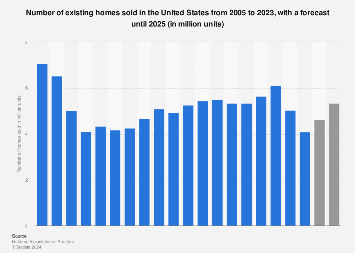
The number of U.S. home sales in the United States declined in 2023, after soaring in 2021. A total of four million transactions of existing homes, including single-family, condo, and co-ops, were completed in 2023, down from 6.12 million in 2021. According to the forecast, the housing market is forecast to head for recovery in the next two years, with the number of sales reaching 5.6 million in 2025.
Why have home sales declined?
The housing boom during the coronavirus pandemic has demonstrated that being a homeowner is still an integral part of the American dream. Nevertheless, sentiment declined in the second half of 2022 and Americans across all generations agreed that the time was not right to buy a home. A combination of factors has led to house prices rocketing, making homeownership unaffordable for the average buyer. A survey among owners and renters found that the high home prices and unfavorable economic conditions were the two main barriers to making a home purchase. People who would like to purchase their own home need to save up a deposit, have a good credit score, and a steady and sufficient income to be approved for a mortgage. In 2022, mortgage rates experienced the most aggressive increase in history, making the total cost of homeownership substantially higher. Only 15 percent of U.S. renters could afford to become homeowners and in metros with highly competitive housing markets such as Los Angeles, CA, and Urban Honolulu, HI, this share was below five percent.
Are U.S. home prices expected to fall?
The median sales price of existing homes stood at 387,000 U.S. dollars in 2023 and was forecast to increase slightly until 2025. The development of the S&P/Case Shiller U.S. National Home Price Index shows that home prices experienced seven consecutive months of decline between June 2022 and January 2023, but this trend reversed in the following months. Despite mild fluctuations throughout the year, home prices in many metros are forecast to continue to grow, albeit at a much slower rate.
